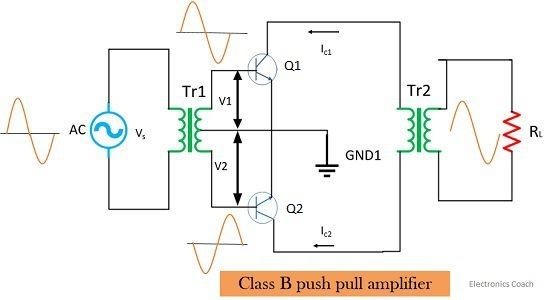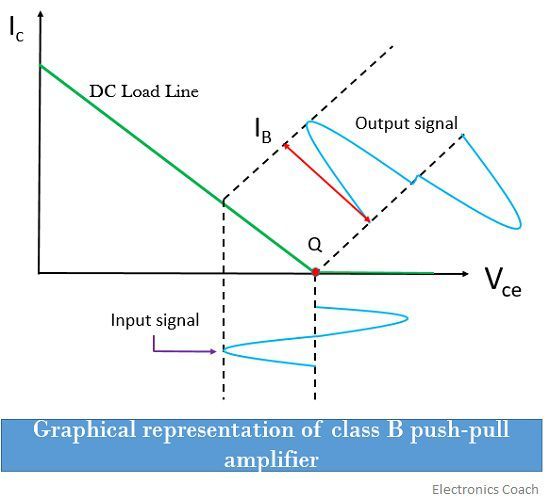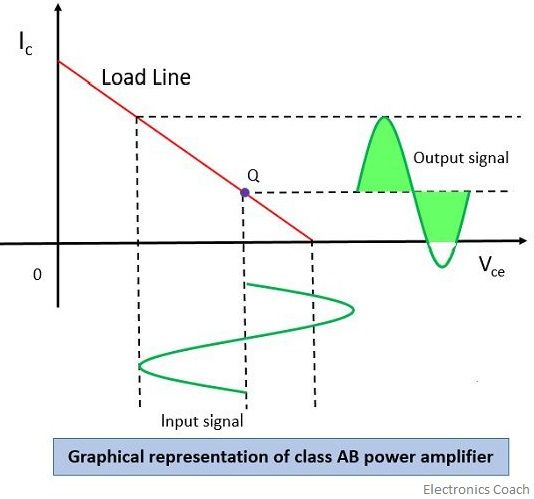Definition: Power amplifiers are basically used to enhance the power level of the input signal. Power amplifier is also called large signal amplifiers, as in order to get large power at the output, input signal voltage required must also be large.
The transistors that are employed in power amplifiers are termed as power transistors.
Key terms of Power Amplifier
- Collector Efficiency: Efficiency is basically measured by the ability to convert dc power into ac power at the output. It is the ratio of ac output power to the dc power from the supply.
- Power dissipation capacity: It is defined as the ability to dissipate the heat generated by the device during operation. As power transistors are designed to handle the large current, it gets heated up at a rapid rate. So, it is necessary to dissipate the heat generated in it.
- Distortion: Distortion can be defined as the changes that occur in output from input during operation. It is always suggested to have a distortionless output.
Stages of Power Amplifiers:
To provide the necessary power amplification, Power amplifiers consist of the following three stages as shown below:

Stage 1: Voltage amplification stage: As the input signal developed by the transducer is of very low value and a higher value signal is needed at the output so input signal is amplified at the very first stage of power amplifiers.
Here, we have used two stages of voltage amplifier so as to amplify the low-value input to the desired level.
Stage 2: Driver stage: The amplified voltage obtained from the voltage amplifier is fed to the driver stage to provide maximum power gain and to facilitate impedance matching.
Stage 3: Output stage: This stage essentially consists of power amplifiers and is responsible to transfer maximum power to the output device.
Classification of Power amplifiers
Power amplifiers are classified as different classes which shows the variation of the output signal with respect to the applied input signal.
Class A
In this class of power amplifiers, the output current flows for overall i.e., 360﮲ of the input cycle. It only operates on the linear region of the load as the operating point is so selected which gives us exact output as that of input.
Here, the maximum possible efficiency is of 50%. This class is used when we simply want a distortion-free output.
Throughout the input signal, the transistor remains in forward bias mode. In this class, the transistor remains in active mode all the time which leads to excessive heat generation thus causing a reduction in the efficiency.
Let’s have a look at the circuit diagram and basic operation of class A amplifier:

When the input voltage is applied at the base terminal of the transistor operating in CE mode it leads to variation in base current, this variation in IB produces similar variation in collector current and the output is taken across the load.

The applied input causes the collector current to fluctuates the collector current from max to min which resultantly moves the Q point along the load line.
Advantages:
- It provides distortionless amplification.
- Small signal can be amplified.
Disadvantages:
- Collector efficiency is low.
- Output power is low.
- Due to excessive heat generation, heat sinks are needed which makes them costly and bulky.
Class B
In this type, the transistor is biased in such a way that the current flows only during the positive half input cycle. In this two complementary transistors are used which receive the input signal of equal magnitude but opposite in phase.
When the input is applied at the centre tapped secondary of transformer it generates two identical signals of opposite phase and the two transistors are driven by these two input signals.
Now the operation is further discussed below:

When V1 goes positive, V2 goes negative which causes Q1 to conduct and Q2 goes in OFF mode. As collector current in Q1 increases, it produces positive half of input signal.
When V1 goes negative and V2 goes positive, Q2 automatically starts conducting and Q1 goes in OFF mode. As the collector current in Q2 increases, it generates another half of the voltage signal.
This operation of the two transistors thus generates a complete sine wave at the output.

When no any input signal is present then both the transistor goes in OFF mode and no current is drawn. This prevents the unnecessary working of the transistor which decreases the chances of overheating of the device.
Working of class B leads to crossover distortion because as we know the voltage of 0.7v is required by the transistor to start its conduction so transistor will not be active below 0.7v. This means that the portion of the wave will not get reproduced at the output leading to distorted output.

This zero crossing distortion is called crossover distortion.
Advantages:
- It is more efficient as compared to the class A power amplifier.
- Even harmonics are avoided because of the push-pull mechanism.
Disadvantages:
- It leads to crossover distortion.
- The cost and size are increased because of coupling transformers.
Class AB
It is a combination of class A and class B type of power amplifiers. This class was basically introduced to eliminate crossover distortion that occurs in class B.
In this type, the angle of conduction lies somewhere between 180﮲ to 360﮲. Here, the transistor biasing is done in such a way that operating point Q lies near cut-off voltage.

The collector current flows for more than half of input cycle that means it conducts during the positive half of the input cycle. For a small portion of the negative half cycle, as the input circuit becomes forward biased.

But the conduction stops for the small portion of the negative half cycle as the transistor goes reverse biased.
Its efficiency lies between 50% to 60%
Advantages:
- It eliminates crossover distortion.
- It is less costly as compared to class B
Disadvantages:
- Efficiency is low.
- There are chances of presence of DC components at the output.
Class C
This class of power amplifier is designed to provide the highest efficiency of about 80%. These are biased in such a way that it operates for less than 180﮲ of the input signal but provides the full output signal in case of resonant frequency tuned circuits.

This class of amplifiers show limited use at a fixed frequency. Distortion is higher in this class so it is not suitable for an audio application.

The collector current flows for less than half cycle of the input signal. The transistor remains idle and does not conduct for more than half portion of the input cycle.
Advantages:
- Power amplifier gives higher efficiency.
- The size of the system is physically small.
Disadvantages:
- It is not good in case of audio applications.
- Linearity of a power amplifier is low.
Class D
It is basically used when we have to operate a digital or pulse type signal. Theoretically, it provides more than 90% efficiency as the current is drawn through ON transistor.
Advantages:
- High Efficiency.
- Power dissipation is low.
Disadvantage:
- Complex system design.
By using class D technique, amplifiers can deliver several hundred watts to the load. Its higher efficiency provides powerful amplifiers with good sound quality.
Anand Bharti says
I like it. Thank you
Shashidhar TM says
Really superb explanation
Eli Richardson says
I found it interesting when you talked about power amplifiers and how they improve a signal’s efficiency. Thanks for the information on power amplifiers and their key elements.